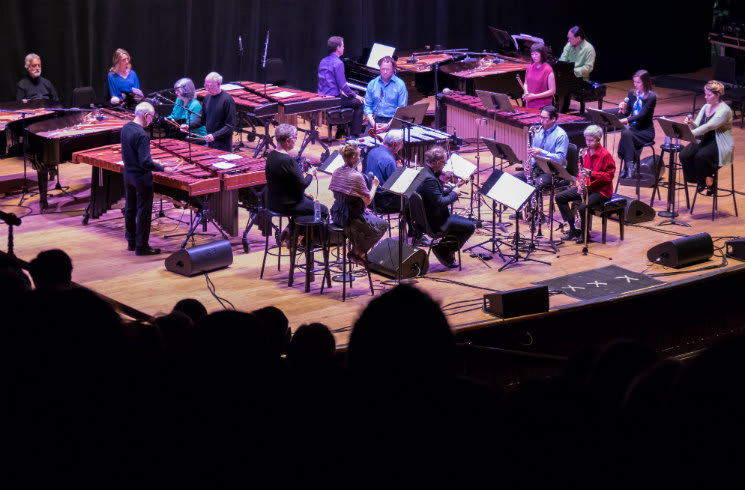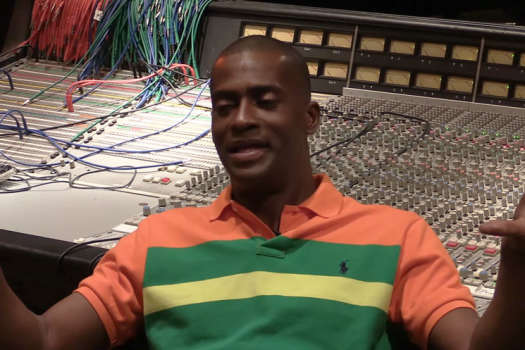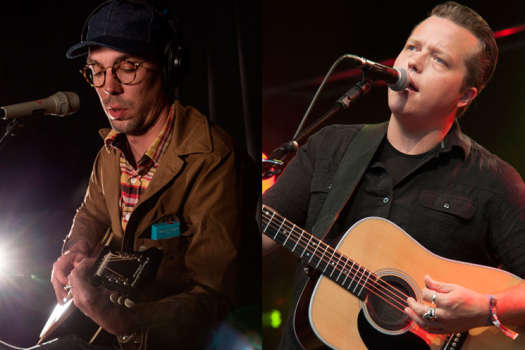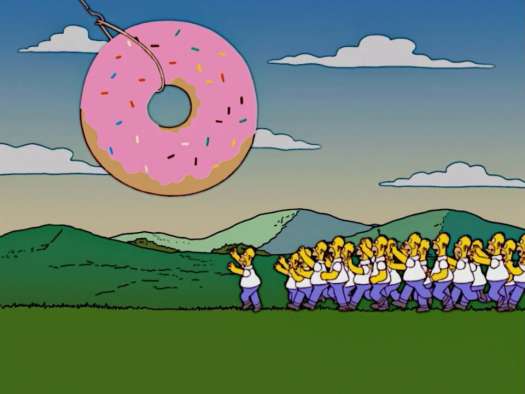Three years in the works, Massey Hall and Soundstreams' Steve Reich at 80 was touted as a celebration of Steve Reich's birthday, but beyond a short introduction, there was curiously little fanfare to the night. After Massey's Director of Programming Chris Lorway and Soundstreams Artistic Director Lawrence Cherney welcomed him to the stage, Reich simply walked out, accompanied by original Steve Reich Ensemble percussionist Russell Hartenberger, and without a word, launched into his 1972 work "Clapping Music."
The piece is conceptually simple but rhythmically complex, and Reich and Hartenberger performed it perfectly. Live, it took on interesting new dynamics, as Reich had audibly softer hands (unless he just claps more softly?) that eked out distinctly different tones than Hartenberger, but otherwise, it was as expected.
Hartenberger joined the orchestra for the second performance of the night, 1981's Tehillim, as Reich left the stage to make way for conductor Leslie Dala.
Breaking the natural order — 1976's Music for 18 Musicians should have come between "Clapping Music" and Tehillim, chronologically, but it was performed after Tehillim and an intermission — was a good decision for the performance, not just because it made for two evenly split halves to the show, but because musically, Tehillim acted as a bridge from "Clapping Music" to Reich's 1976 masterwork; it retained the irregular rhythms and body percussion of the former, but introduced the melodic phrases that link it to Music for 18 Musicians.
The piece required incredible stamina from the four singers — Canadian sopranos Lesley Bouza, Michelle DeBoer and Carla Huhtanen, and Grammy-nominated alto Laura Pudwell — as they climbed up and down their broad registers to cover the all-over-the-place range of their parts. The lead soprano, particularly, barely had time to crouch down for a swig of water.
"Parts I & II," the more dynamic half of the composition, found the rhythm section working hard, but it was the strings, whose emphatic swells defined the piece almost as much as the voices, had to time things just right, and for the most part, they were flawless. "Parts III and IV" is the lesser half of the recorded version, to my mind, but the performance lent the piece extra weight, particularly during the climactic "Hallelujah" parts near the end.
With so much happening at all times, and with the piece in such irregular timing, it required incredible communication between the musicians and, especially, between conductor Dala and the orchestra, and they pulled it off with aplomb.
After an intermission, the stage was reset with four baby grand pianos, two xylophones, three marimbas and a metallophone, ready for the performance of Reich's inarguable masterpiece, and one of the most influential compositions of the 20th century, Music for 18 Musicians. Tanya Tagaq collaborator Jesse Zubot took his seat as the ensemble's violinist, while famed clarinettist Lori Freedman sat flanked by both her primary instrument and the bass clarinet, as the piece demanded.
Hartenberger and another percussionist kicked off the marimbas of "Pulses," and the vocalists poured their undulating voices into the microphones, pulling them away to create the distancing effect achieved on record. They were in for a long performance — it would go 25 minutes beyond its usual 55 or so minutes — and the piece is already hard enough on singers, as they're tasked with making their voices sound, as much as possible, like instrumental loops.
Music for 18 Musicians can be an overwhelming composition upon first listen, but over time, it reveals itself; live, it was even more nuanced, almost understated, perhaps because of the actual physical space between the 18 performers onstage. "Pulses," particularly, was delicate and beautiful, and as would happen throughout the performance, the addition of one instrument — in its first occurrence, the addition of the third marimba for "Section I" — was seismic.
Watching each player was a pleasure, especially when you could see them adding notes, one by one, to their at-first-simple phrases, transitioning into their full phrases as another instrument transitioned out. It was a musical kaleidoscope, but by focusing on one shape, you could see the individual fragmentary colours making up the pattern, if only for a moment, before shifting your focus back to the ensemble as a whole.
By "Section IV" and "Section V," it was as if all of the musicians, now all engaged, were softly conversing, the string and woodwinds providing urgency as the vocals and piano chattered away. Zubot, used to wreaking havoc alongside Tagaq onstage, was playing with so much vigour that it looked difficult for him to stay seated, particularly during the more driving string parts.
As the players traded spots guiding the melody, the musicians were swapping places increasingly too, as players moved from piano to marimba, vocals to piano, marimba to shaker; at one point, three musicians were playing the same marimba.
Perhaps the most fascinating aspect of seeing the influential piece come to life, though, was the constant reminder that the loops you hear on record are not computer-derived; they're played by human beings with unbelievable stamina, who are creating loops that stem from their bodies as they strain their muscles to meet the demands of the composition's precise repetition. The piece has played a crucial role in shaping modern electronic music, and yet there are no samples or digital enhancement of any kind in the original, meaning endurance is key; there is no room for weariness in Music for 18 Musicians.
The piece reached its thrilling climax about an hour in, as the players struck, pushed and pulled their instruments and, by extension, their bodies (except maybe the metallophonist, whose struck notes rung out celestially over the din), and when it came to a close almost half an hour later than it should have, with the two percussionists back at the marimbas they started on, there was a visible mix of relief and joy on the faces of the musicians onstage.
They were joined by Reich himself for a full ensemble bow, and were met, deservedly, with a standing ovation. It was a thrilling, perception-altering way to hear an already formative piece of music from a living legend.
The piece is conceptually simple but rhythmically complex, and Reich and Hartenberger performed it perfectly. Live, it took on interesting new dynamics, as Reich had audibly softer hands (unless he just claps more softly?) that eked out distinctly different tones than Hartenberger, but otherwise, it was as expected.
Hartenberger joined the orchestra for the second performance of the night, 1981's Tehillim, as Reich left the stage to make way for conductor Leslie Dala.
Breaking the natural order — 1976's Music for 18 Musicians should have come between "Clapping Music" and Tehillim, chronologically, but it was performed after Tehillim and an intermission — was a good decision for the performance, not just because it made for two evenly split halves to the show, but because musically, Tehillim acted as a bridge from "Clapping Music" to Reich's 1976 masterwork; it retained the irregular rhythms and body percussion of the former, but introduced the melodic phrases that link it to Music for 18 Musicians.
The piece required incredible stamina from the four singers — Canadian sopranos Lesley Bouza, Michelle DeBoer and Carla Huhtanen, and Grammy-nominated alto Laura Pudwell — as they climbed up and down their broad registers to cover the all-over-the-place range of their parts. The lead soprano, particularly, barely had time to crouch down for a swig of water.
"Parts I & II," the more dynamic half of the composition, found the rhythm section working hard, but it was the strings, whose emphatic swells defined the piece almost as much as the voices, had to time things just right, and for the most part, they were flawless. "Parts III and IV" is the lesser half of the recorded version, to my mind, but the performance lent the piece extra weight, particularly during the climactic "Hallelujah" parts near the end.
With so much happening at all times, and with the piece in such irregular timing, it required incredible communication between the musicians and, especially, between conductor Dala and the orchestra, and they pulled it off with aplomb.
After an intermission, the stage was reset with four baby grand pianos, two xylophones, three marimbas and a metallophone, ready for the performance of Reich's inarguable masterpiece, and one of the most influential compositions of the 20th century, Music for 18 Musicians. Tanya Tagaq collaborator Jesse Zubot took his seat as the ensemble's violinist, while famed clarinettist Lori Freedman sat flanked by both her primary instrument and the bass clarinet, as the piece demanded.
Hartenberger and another percussionist kicked off the marimbas of "Pulses," and the vocalists poured their undulating voices into the microphones, pulling them away to create the distancing effect achieved on record. They were in for a long performance — it would go 25 minutes beyond its usual 55 or so minutes — and the piece is already hard enough on singers, as they're tasked with making their voices sound, as much as possible, like instrumental loops.
Music for 18 Musicians can be an overwhelming composition upon first listen, but over time, it reveals itself; live, it was even more nuanced, almost understated, perhaps because of the actual physical space between the 18 performers onstage. "Pulses," particularly, was delicate and beautiful, and as would happen throughout the performance, the addition of one instrument — in its first occurrence, the addition of the third marimba for "Section I" — was seismic.
Watching each player was a pleasure, especially when you could see them adding notes, one by one, to their at-first-simple phrases, transitioning into their full phrases as another instrument transitioned out. It was a musical kaleidoscope, but by focusing on one shape, you could see the individual fragmentary colours making up the pattern, if only for a moment, before shifting your focus back to the ensemble as a whole.
By "Section IV" and "Section V," it was as if all of the musicians, now all engaged, were softly conversing, the string and woodwinds providing urgency as the vocals and piano chattered away. Zubot, used to wreaking havoc alongside Tagaq onstage, was playing with so much vigour that it looked difficult for him to stay seated, particularly during the more driving string parts.
As the players traded spots guiding the melody, the musicians were swapping places increasingly too, as players moved from piano to marimba, vocals to piano, marimba to shaker; at one point, three musicians were playing the same marimba.
Perhaps the most fascinating aspect of seeing the influential piece come to life, though, was the constant reminder that the loops you hear on record are not computer-derived; they're played by human beings with unbelievable stamina, who are creating loops that stem from their bodies as they strain their muscles to meet the demands of the composition's precise repetition. The piece has played a crucial role in shaping modern electronic music, and yet there are no samples or digital enhancement of any kind in the original, meaning endurance is key; there is no room for weariness in Music for 18 Musicians.
The piece reached its thrilling climax about an hour in, as the players struck, pushed and pulled their instruments and, by extension, their bodies (except maybe the metallophonist, whose struck notes rung out celestially over the din), and when it came to a close almost half an hour later than it should have, with the two percussionists back at the marimbas they started on, there was a visible mix of relief and joy on the faces of the musicians onstage.
They were joined by Reich himself for a full ensemble bow, and were met, deservedly, with a standing ovation. It was a thrilling, perception-altering way to hear an already formative piece of music from a living legend.




